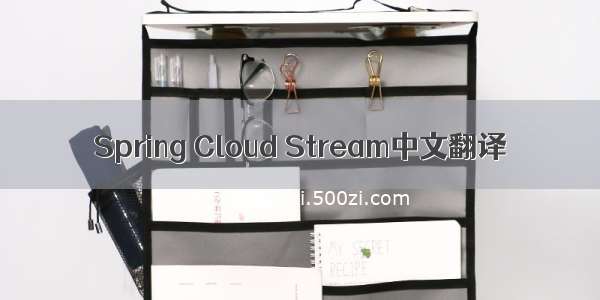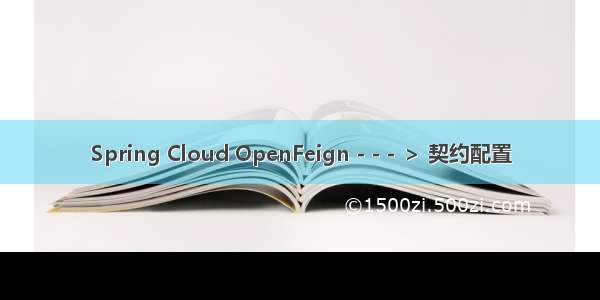
3.0.1
本项目通过自动配置和绑定到spring环境和其他spring编程模型习惯用法为OpenFeigh提供共针对spring boot应用的整合。
1. 声明式REST客户端:Feign
Feign是一个声明式web服务客户端。它使得编写web服务客户端更加容易。使用Feign创建一个接口并对其进行注解标注。它包含可插入式注解支持,包括Feign注解和JAX-RS注解。Feign同样支持可插入式编码器和解码器。Spring Cloud为其增加了对Spring MVC注解和与Spring Web默认的HttpMessageConverters的支持。在使用Feign时Spring Cloud整合了Eureka、Spring Cloud CircuitBreak以及Spring Cloud LoadBalancer提供了一个http协议的负载均衡客户端。
1.1. 如何包含Feign
使用org.springframework.cloud goupId和spring-cloud-stater-openfeign artifactId来在你的项目中包含Feign.参阅Spring Cloud的项目主页来获取使用当前的Spring Cloud发布版本配置你的构建系统的详情。
Spring Boot应用实例:
@SpringBootApplication@EnableFeignClientspublic class Application {public static void main(String[] args) {SpringApplication.run(Application.class, args);}}
StoreClient.java(译者注:store没有特殊含义,并不是你必须使用store。这与你的具体项目有关,假如你正在开发一个天气的客户端,那你的名字就可能是WeatherClient.java)
@FeignClient("stores")public interface StoreClient {@RequestMapping(method = RequestMethod.GET, value = "/stores")List<Store> getStores();@RequestMapping(method = RequestMethod.GET, value = "/stores")Page<Store> getStores(Pageable pageable);@RequestMapping(method = RequestMethod.POST, value = "/stores/{storeId}", consumes = "application/json")Store update(@PathVariable("storeId") Long storeId, Store store);}
在@Feign注解中的字符串值(上面的是“store”)代表了任意的客户端名字,他将用来创建一个Spring Cloud 负载均衡客户端。你也可以使用url属性指定一个URL(绝对路径值或者只有一个主机名)。该接口对应的Bean在应用上下文中的名字为该接口的全限定名称。你可以使用@FeignClient注解的qualifier属性来定义你自己的别名。
上面的负载均衡客户端将试图发现“store”服务的物理地址。如果你的应用是一个Eureka客户端,它将在Eureka服务的注册中心获取到。如果你不想使用Eureka,你可以在你的外部配置中使用SimpleDiscoverClient简单地配置一个服务列表。
Spring Cloud OpenFeign支持Spring Cloud LoadBalancer阻塞模型的所有功能。你一在项目文档中读取更多他们的信息。
1.2. 覆盖Feign的默认配置
Spring Cloud对Feign支持的一个核心盖面是命名客户端。每个Feign客户端都是集成组件的一部分,全体客户端合作工作按需连接远程客户端。应用程序开发者可以使用@FeignClient注解来给集成组件命名。Spring Cloud使用FeignClientsConfiguration按需为每个命名客户端创建一个ApplicationContext集成。其中包括一个feign.Decoder、一个feign.Encoder和一个feign.Contract。你可以使用@FeignClient注解的contextId属性覆盖集成组件的名字。
Spring Cloud允许你使用@FeignClient注解声明额外配置完全控制Feign客户端(在FeignClientsConfiguration)。
示例:
@FeignClient(name = "stores", configuration = FooConfiguration.class)public interface StoreClient {//..}
在本示例中,客户端由存在于FeignClientsConfiguration和FooConfiguration中的组件组成(后面将会覆盖前面的FooConfiguration)。
FooConfiguration不需要使用@Configuration注解标注。然而,如果这样做了,一定要注意在任何可能扫描到该配置的@ComponentScan中排除它。否则包含了该配置将会将feign.Decoder、feign.Encoder、feign.Contract等作为默认源,如果定义了的话。这可以通过将配置放置到一个独立、不重复的非@ComponentScan和@SpringBootApplication包中避免,或者明确的在@ComponentScan中排除。
使用@FeignClient注解的contextId属性除了更改ApplicationContext集成的属性之外,还会覆盖客户端的别名,该别名将会创建客户端的配置bean的名字的一部分。
以前,使用url属性不要求必须使用name属性。现在name属相被强制要求使用。
name和url属相支持位置标识符。
@FeignClient(name = "${feign.name}", url = "${feign.url}")public interface StoreClient {//..}
Spring Cloud OpenFeign默认为feign提供如下bean(beanType beanName: ClassName):
Decoder feignDecoder: ResponseEntityDecoder(包装这一个Spring Decoder)Encoder feignEncoder: SpringEncoderLogger feignLogger: Self4jLoggerContract feignContract: SpringMvcContractFeign.Builder feignBuilder: FeignCircuitBreaker.BuilderClient feignClient: 如果Spring Cloud LoadBalancer在classpath中,FeignBlockingLoadBalancerClient被使用。如果没有东西在classpath中,默认的feign client被使用。
spring-cloud-stater-openfeign支持spring-cloud-stater-loadbalancer。然而,作为一个可选的依赖,你如果想要使用它就必须确定它已将被加入到你的项目中。
可以通过设置feign.okhttp.enabled或者feign.httpclient.enabled为true来使用OkHttpClient或者ApacheHttpClient,分别在classpath中添加他们的依赖。你可以通过提供一个org.apache.http.impl.client.CloseableHttpClient(在使用ApacheHttpClient时)或者okhttp3.OkHttpClient bean自定义被使用的客户端。
Spring Cloud OpenFeign 默认不为feign提供如下所示的bean,但是仍然从应用上下文中查找这些类型的bean来创建feign客户端:
Logger.LevelRetryerErroeDecoderRequest.OptionsCollection< RequestInterceptor >SetterFactoryQueryMapEncoder
一个Retryer.NEVER_RETRY bean默认被创建为Retryer类型,这将会禁止重试操作。注意这个重试操作与Feign默认的不同,它将会自动重试IOExceptions,将他们作为暂时网络连接异常对待并且将任何RetryableException从一个ErrorDecoder抛出。
创建一个对应类型的bean并将它放到一个@FeignClient配置中使得你可以覆盖对应的bean。
示例:
@Configurationpublic class FooConfiguration {@Beanpublic Contract feignContract() {return new feign.Contract.Default();}@Beanpublic BasicAuthRequestInterceptor basicAuthRequestInterceptor() {return new BasicAuthRequestInterceptor("user", "password");}}
此例使用feign.Contract.Default代替SpringMvcContract并向RequestInterceptor集合中添加了一个RequestInterceptor。
@FeignClient也可以使用属性配置文件进行配置。
application.yml
feign:client:config:feignName:connectTimeout: 5000readTimeout: 5000loggerLevel: fullerrorDecoder: com.example.SimpleErrorDecoderretryer: com.example.SimpleRetryerdefaultQueryParameters:query: queryValuedefaultRequestHeaders:header: headerValuerequestInterceptors:- com.example.FooRequestInterceptor- com.example.BarRequestInterceptordecode404: falseencoder: com.example.SimpleEncoderdecoder: com.example.SimpleDecodercontract: com.example.SimpleContract
在@EnableFeignClients中使用与上面相似的语法在defaultConfiguration属性中指定默认配置。不同之处在于此配置将会运用到所有的feign客户端中。
如果你更喜欢使用属性配置文件配置所有的@FeignClient,你可以将default作为feign名作为配置属性。
你可以使用feign.client.config.feignName.defaultQueryParameters和feign.client.config.feignName.defaultRequestHeaders来指定查询参数和头部,这些参数和头部将随名称为fileName的客户端的请求一起发送。
application.yml
feign:client:config:default:connectTimeout: 5000readTimeout: 5000loggerLevel: basic
如果你即创建了@Configuration bean又创建了配置属性,配置属性将优先使用。配置属性将覆盖@Configuration的值。但是如果你想要改变@Configuration的优先级,你可以将feign.client.default-to-properties的值改为false。
如果你想使用相同的名称或url创建多个feign客户端,这些客户端可能会指向相同的服务,但是却使用不同的自定义配置。我们必须使用@FeignClient的contextId属性来避免这些配置bean的名字冲突。
@FeignClient(contextId = "fooClient", name = "stores", configuration = FooConfiguration.class)public interface FooClient {//..}
@FeignClient(contextId = "barClient", name = "stores", configuration = BarConfiguration.class)public interface BarClient {//..}
还可以将FeignClient配置为不从父上下文继承bean。可以通过重写FeignClientConfigurer bean中的inheritParentConfiguration()返回false来实现这一点:
@Configurationpublic class CustomConfiguration{@Beanpublic FeignClientConfigurer feignClientConfigurer() {return new FeignClientConfigurer() {@Overridepublic boolean inheritParentConfiguration() {return false;}};}}
默认情况下,外部客户机不编码斜杠/字符。你可以通过将feign.client.decodeSlash设置为false来改变这一行为。
1.3. 超时处理
我们既可以设置默认的超时配置,也可以针对某一个命名客户端做超时配置。OpenFeign通过两个超时参数进行工作:
contectTimeout 防止由于服务器的长处理时间而阻塞调用。readTime 应用于连接建立时间,在返回响应花费时间过长时被触发。
一旦服务没有运行或者收到了一个连接失败的包。通讯将以错误消息或者回退结束。如果connectTimeout被设置的过晚,这些可能会在连接超时之前发生。执行查询和接收这样一个数据包花费的时间 导致了很大一部分时间。它可能会根据涉及DNS查找的远程主机进行更改。
1.4. 手动创建Feign客户端
在一些情况下,不使用上面的方法自定义你的Feign客户端是很有必要的。在这时候,你可以使用Feign Builder API来创建Feign客户端。下面是一个使用相同的接口但使用两个独立的请求拦截器创建两个Feign客户端的示例。
@Import(FeignClientsConfiguration.class)class FooController {private FooClient fooClient;private FooClient adminClient;@Autowiredpublic FooController(Decoder decoder, Encoder encoder, Client client, Contract contract) {this.fooClient = Feign.builder().client(client).encoder(encoder).decoder(decoder).contract(contract).requestInterceptor(new BasicAuthRequestInterceptor("user", "user")).target(FooClient.class, "https://PROD-SVC");this.adminClient = Feign.builder().client(client).encoder(encoder).decoder(decoder).contract(contract).requestInterceptor(new BasicAuthRequestInterceptor("admin", "admin")).target(FooClient.class, "https://PROD-SVC");}}
在上面的示例中,FeignClientConfiguration.class是Spring Cloud OpenFeign提供的默认配置。
PROD-SVC是客户端将要发送请求的服务端名称。
Feign Contract对象定义了哪种注解和值在接口中是合法的。自动注入的Contract bean提供了对Spring MVC注解的支持,不支持Feign原生注解。
你也可以调用Builder的inheritParentContext(false)方法配置Feign客户端,使其不从父上下文中继承bean。
1.5. Feign支持Spring Cloud CircuitBreaker
如果Spring Cloud CricuitBreaker在classpath中,并且feign.cricuitbreaker.enabled=true,Feign将会使用一个断路器包裹所有方法。
通过使用@Scope(“prototype”)注解创建一个Feign.Builderber bean可以在所有的客户端中禁用Spring Cloud CricuitBreaker支持:
@Configurationpublic class FooConfiguration {@Bean@Scope("prototype")public Feign.Builder feignBuilder() {return Feign.builder();}}
断路器的命名遵循 <feignClientName>_<calledMethod>模式。当使用名字为foo的Feign客户端调用接口的bar方法时,断路器名字将会是foo_bar。
1.6 Feign 与Spring Cloud CricutBreaker回退
Spring CricuitBreaker支持回退的概念:当链路开路或者发生错误时一个默认的代码路径将会被执行。通过设置@FeignClient的fallback属性值为实现了回退的类的类名使Feign客户端支持回退。你仍然需要将该实现声明为一个Spring bean。
@FeignClient(name = "test", url = "http://localhost:${server.port}/", fallback = Fallback.class)protected interface TestClient {@RequestMapping(method = RequestMethod.GET, value = "/hello")Hello getHello();@RequestMapping(method = RequestMethod.GET, value = "/hellonotfound")String getException();}@Componentstatic class Fallback implements TestClient {@Overridepublic Hello getHello() {throw new NoFallbackAvailableException("Boom!", new RuntimeException());}@Overridepublic String getException() {return "Fixed response";}}
如果你想获取触发回退的原因,你可以使用@FeignClient注解的fallbackFactory属性。
@FeignClient(name = "testClientWithFactory", url = "http://localhost:${server.port}/",fallbackFactory = TestFallbackFactory.class)protected interface TestClientWithFactory {@RequestMapping(method = RequestMethod.GET, value = "/hello")Hello getHello();@RequestMapping(method = RequestMethod.GET, value = "/hellonotfound")String getException();}@Componentstatic class TestFallbackFactory implements FallbackFactory<FallbackWithFactory> {@Overridepublic FallbackWithFactory create(Throwable cause) {return new FallbackWithFactory();}}static class FallbackWithFactory implements TestClientWithFactory {@Overridepublic Hello getHello() {throw new NoFallbackAvailableException("Boom!", new RuntimeException());}@Overridepublic String getException() {return "Fixed response";}}
1.7. Feign 和 @Parimary
当Feign使用Spring Cloud CricuitBreaker回退时,在一个ApplicationContext中会有多个相同类型的bean。由于没有一个确定的bean或没有被标记为primary,@Wutowired注解将不能使用。为了能够正常工作,Spring Cloud OpenFeign将所有头的Feign标记为@Primary,因此,spring将会知道那个bean将被用来注入。在一些情况下,这可能不是那么称心如意。可以通过将@FeignClient注解的primary属性设置为false来关闭这一行为。
@FeignClient(name = "hello", primary = false)public interface HelloClient {// methods here}
1.8. Feign的继承支持
Feign通过单继承支持样板api。这允许将常见操作分组到方便的基本接口中。
UserService.java
public interface UserService {@RequestMapping(method = RequestMethod.GET, value ="/users/{id}")User getUser(@PathVariable("id") long id);}
UserResource.java
@RestControllerpublic class UserResource implements UserService {}
UserClient.java
package project.user;@FeignClient("users")public interface UserClient extends UserService {}
通常不建议在服务器和客户机之间共享接口。它引入了紧耦合,并且实际上不适用于springmvc的当前形式(方法参数映射不是继承的)。
1.9. Feign 请求/响应 压缩
您可以考虑为您的外部请求启用请求或响应GZIP压缩。您可以通过启用以下属性之一来执行此操作:
pression.request.enabled=pression.response.enabled=true
Feign 请求/响应 压缩提供的设置与您可能为web服务器设置的设置类似:
pression.request.enabled=pression.request.mime-types=text/xml,application/xml,application/pression.request.min-request-size=2048
这些属性允许您选择压缩媒体类型和最小请求阈值长度。
对于除OkHttpClient之外的http客户端,可以启用默认的gzip解码器来解码UTF-8编码的gzip响应:
pression.response.enabled=pression.response.useGzipDecoder=true
1.10. Feign日志
为每个创建的外部客户机创建一个记录器。默认情况下,记录器的名称是用于创建外部客户机的接口的完整类名。外部日志记录只响应DEBUG级别。
application.yml
logging.level.project.user.UserClient: DEBUG
你可以为每个客户端配置Logger.level对象,告诉Feign要记录多少。选择包括:
NONE,不记录(默认)BASIC,只记录请求方法和URL以及响应状态代码和执行时间。HEADERS,记录基本信息以及请求和响应头。FULL,记录请求和响应的头、正文和元数据。
例如,下面将设置Logger至FULL:
@Configurationpublic class FooConfiguration {@BeanLogger.Level feignLoggerLevel() {return Logger.Level.FULL;}}
1.11. Feign支持@QueryMap注解
OpenFeign的@QueryMap注解提供POJO被用于GET参数映射的支持。不幸的是,默认的OpenFeign的@QueryMap注解由于缺少value属性与Spring是不相容的。
Spring Cloud OpenFeign提供了一个等价的@SpringQueryMap注解,此注解将被用于注释POJO或Map参数作为查询参数映射。
例如,Params类定义了param1和param2参数:
// Params.javapublic class Params {private String param1;private String param2;// [Getters and setters omitted for brevity]}
下面的feign客户端通过使用@SpringQueryMap注解使用Params类:
@FeignClient("demo")public interface DemoTemplate {@GetMapping(path = "/demo")String demoEndpoint(@SpringQueryMap Params params);}
如果你想在生成的查询参数之上获取更多控制,你可以实现自定义的QueryMapEncoder bean。
1.12. HATEOAS 支持
Spring 提供了一些创建符合HATEOAS原则、Spring Hateoas和Spring Data REST的REST表示的API。
如果你的项目使用了org.springframework.boot:spring-boot-starter-hateoas或者org.framework.boot:spring-boot-starter-data-rest启动器,Feign HATEOAS将被默认启动。
当HATEOAS支持被启用后,Feign客户端被允许序列化和反序列化HATEOAS表述模型:EntityModel、CollectionModel和PagedModel。
@FeignClient("demo")public interface DemoTemplate {@GetMapping(path = "/stores")CollectionModel<Store> getStores();}
1.13. Spring @MatriVariable 支持
Spring Cloud OpenFeign提供对Spring@MatriVariable注解的支持。
如果一个方法参数被以map的形式传递,@MatriVariable路径段是通过加入map中以等号连接的键值对被创建的。
如果传递了另一个对象,则@MatrixVariable注释中提供的名称(如果已定义)或带注释的变量名称将使用=,与提供的方法参数联接。
重点
尽管在服务端,Spring不要求用户使用与matrix变量名同名的路径段占位符,因为这可能使得在客户端比较模糊,但Spring Cloud OpenFeign要求你在路径段占位符命名与@MatrixVariable的name属性值(如果定义了的话)或者声明的变量名相匹配。
例如:
@GetMapping("/objects/links/{matrixVars}")Map<String, List<String>> getObjects(@MatrixVariable Map<String, List<String>> matrixVars);
注意变量名和路径段占位符都叫matrixVars。
@FeignClient("demo")public interface DemoTemplate {@GetMapping(path = "/stores")CollectionModel<Store> getStores();}
1.14 Feign CollectionFormat支持
我们通过@CollectionFormat注解提供对feign.CollectionFormat的支持。你可以通过向他传递一个要求的feign.CollectionFormat作为注解的值使用它注解一个Feign客户端方法。
在下面的例子中,CSV格式被用来代替默认的EXPLODED来处理方法。
@FeignClient(name = "demo")protected interface PageableFeignClient {@CollectionFormat(feign.CollectionFormat.CSV)@GetMapping(path = "/page")ResponseEntity performRequest(Pageable page);}
在发送Pageable作为查询参数时设置CSV格式,以便正确编码。
1.15. Reactive支持
由于OpenFeign项目目前不支持被动客户机,比如springwebclient,springcloud也不支持对外开放。我们一旦它在核心项目中可用,就会在这里添加对它的支持。
在此之前,我们建议使用feign reactive来支持springwebclient。
1.15.1. 早期初始化错误
根据您使用feign户机的方式,启动应用程序时可能会看到初始化错误。要解决此问题,可以在自动连接客户端时使用ObjectProvider。
@AutowiredObjectProvider<TestFeginClient> testFeginClient;
1.16. Spring Data 支持
您可以考虑启用Jackson模块来提供支持org.springframework.data.domain.Page以及org.springframework.data.domain.Sort解码。
feign.autoconfiguration.jackson.enabled=true
2. 配置属性
要查看所有与Sleuth相关的配置属性的列表,请查看附录页。














